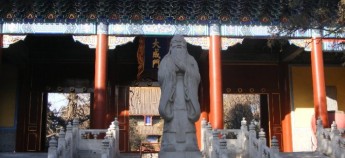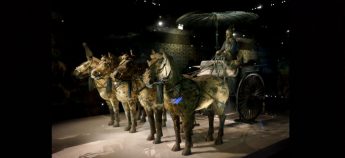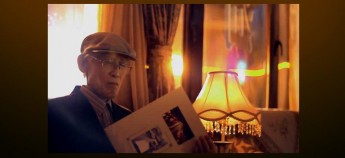Pinnacle of Buddhism Architecture – Datong, Shanxi, The YunGang Grottoes and XuanKongSi Hanging Monastery.

Intricate art on the cave walls of YunGang Grottoes that carried some influence from India and its colours lasted for centuries.
Text/Photos: Jessica Chan
In my journey of 20,000km around China, if I have to list something that was really mind-boggling, it has to be the YunGang Grottoes and XuanKongSi Hanging Monastery of Datong. Tucked far in the northern province of Shanxi, Datong is relatively off the normal tourist route. This is my usual preference as I could take my own sweet time and explore the place to my heart’s content.
YunGang Grottoes
In China, there are three well-known grottoes where Buddha and religious sculptures and art were carved out of mountains and painted in caves. The most famous one is the MoGao Grottoes of DunHuang (Gansu), the other is LongMen Grottoes of LuoYang (Henan) and YunGang Grottoes of Datong (Shanxi). In terms of history, MoGao is the oldest with about 1600 years of age followed by LongMen and YunGang built 1500 years ago. Having visited both MoGao and YunGang, I would still prefer the YunGang Grottoes. Firstly, photography is allowed here (unlike MoGao). Secondly, visitors are allowed to explore the place at their own pace without being ushered around. Thirdly, it is does have the crowd like MoGao and is entrance fee is cheaper.
Although there are about 252 caves at YunGang Grottoes, there are about 45 caves that are still intact and only about 20 over caves are open to visitors. The others are probably inaccessible or yet to be restored. What is so special about these caves? It is of historic significance that they originated around 460 AD when the Buddhism first came to China. It was amazing to note how those people were able to create a complex of grottoes that spans 1km in length with the simplest of tools and probably the strongest enthusiasm. The tallest Buddha sculpture reached a height of more than 13m and intricate carvings and paintings covered walls and roofs of the caves. It is also interesting to note that the facial features of early sculptures of Buddha took on more influence of Indian features. While Buddha sculptures of later times began to transform more into a Chinese look.
YunGang Grottoes is inscribed as UNESCO World Heritage Site in 2001. Entrance fee is RMB150.
XuanKongSi Hanging Monastery
This is a stunning ancient architecture that left me gasping for breath. It is literally a temple plugged into the side of the mountain cliff and supported only by stilts, that’s superb architectural techniques and how they did it was absolutely mind-boggling. This monastery is actually part of HengShan, one of the 5 Sacred Mountains of China. As it is located on the other side of the mountain, it is a stand-alone attraction. Built around the year 490AD this monastery is a combination of three religions – Buddhism, Confucianism and Taoism. Amazingly, this architectural feat holds about 40 halls in the air, connected by extremely narrow walkways and stairs. Entrance fee is RMB130.
These are the two main features that made my trip to this far northern city (Datong) rewarding and satisfying. Of course, these are not the only two things that I came here for. I also spent some time exploring some attractions in the city and checking out the lifestyle of the local people.

Huayan Temple is the largest and well preserved temple of the Liao (916-1125) and Jin (1115-1234) dynasties in China.
Getting there and around
Only fast trains and local trains run between Beijing West Station (Beijing Xi Zan) to Datong. There are no express trains or bullet trains servicing this route. So it is better to take a sleeper berth for this 6 hours journey as the seats are not that comfortable.
At Datong, Bus No.3 plies between the Datong and YunGang Grottoes. The bus stop is only ashort distance from the Datong Railway Station and bus fare is RMB1.50. Another alternative is to hire a taxi for a day trip to several locations like the XuanKong Hanging Monastery, the Pagoda, etc. which costs around RMB200-300 with some bargaining.

Yingxian Wooden Pagoda is the oldest and tallest wooden pagoda in China built in 1056 that has amazingly survived many natural disasters.

One of the three famous Nine Dragon Wall it is the oldest and largest glazed wall in China. The other two are located in the Forbidden City and Beihai Park.
Datong is the northern city of Shanxi Province. As this province is located west of the Taihang Mountains, hence its name Shanxi which literally means west of the mountains. Shanxi is sometimes known as Jin, in reference to the former province that was here during the ancient times. During the ancient days, Shanxi was the centre of trade and banking and hence, Shanxi Merchants were synonymous with wealth and power. The capital city of Shanxi is Taiyuan and the other famous city of Shanxi is the heritage city of Pingyao where the Pingyao International Photography Festival is held every year.
Text & Photo by Travelution
全球超过80000家酒店,Apple101助您轻松订房,出行无忧,绝对优惠价。入住期间付款,多数客房可免费取消!

















